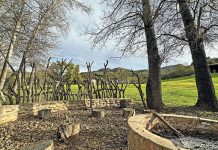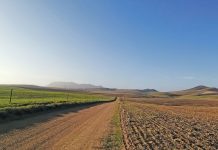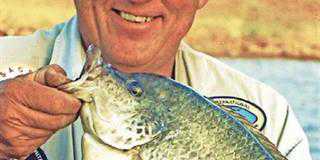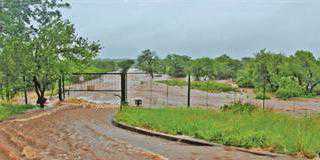As I rolled over, adrenalin shot through my veins and I saw the undulating shape of a huge crocodile 1m below me. My interest in crocodiles started in Grade 8 when my geography teacher, who didn’t teach us much about his subject, told us many fascinating stories about his young days as a professional crocodile hunter in the Okavango. He called them “flat dogs”. Although I didn’t know much in the exams about geography, I scored top marks for an essay about these “dogs” and in years to come almost came second in several encounters with them.
Story of old “one eye”
While training conservation officers in Lebowa during the 1980s, a report came in of a large crocodile, stranded about 5km from the main Olifants River in a dry water course, where it apparently went after a violent rainstorm. Arriving on the scene with a team of helpers, I noticed the crocodile was half blind, as its one eye socket was empty. Stalking it from its blind side we managed to get a noose around its top jaw and strapped the 4m-long reptile to a pole. We then transferred and released it in the nearby Arabie Dam.
About a year later my youngest son Rolf and I were in my boat on the dam, fishing for tilapia. Several giant camel thorn trees that stood on the riverbank before the dam was built protruded above the surface. A prerequisite to fish successfully for the fat tilapia that lived among the submerged branches was a stealthy approach, so we drifted quietly towards one of the drowned trees but to our surprise we stalked more than tilapia – among the branches lay a huge crocodile partly exposed, basking in the afternoon sun.
As we drew closer, it puzzled us that the big reptile remained motionless and I wondered if it was alive. Suddenly I recognised the croc as the one that I had captured the year before and released in the dam. His eye socket on our side was empty, preventing him from seeing us. Arabie was full of large crocodiles, including a monster of over 5m, and the last thing I expected was to meet old “one eye” again. As we drifted past his nose tip, his other eye saw us and in a flash he slipped under the surface. At that moment my son drew my attention to a fish eagle flying low overhead. As I turned around, I lost my balance and that’s when I fell overboard.
Fortunately his fright was as big as mine and with my heart racing and my eyes wide open underwater, I watched as he disappeared into the darkness of the depths. Although the great heyday of reptiles is long gone, the few survivors of the catastrophe that wiped out the dinosaurs has left a multitude of descendants that developed into 5 400 species of crawly creatures of every shape, size and colour that inhabit most parts of the globe, except the poles. In contrast, the 21 species of crocodilians that remain are all ancient and so similar in appearance that only an expert can tell them apart.
Although at least five croc species, including the Australian saltwater crocodile, grow considerably larger than the African Nile crocodile, I have no doubt that ours is the strongest reptile in the world today, due to the robust game it preys on. Selous’s book African Nature Notes and Reminiscences has a fascinating account of an adult black rhino cow being attacked and eventually drowned by a large crocodile. It is more remarkable if one considers that a crocodile cannot hold onto anything and can only pull by the backward swimming action of its immensely powerful tail.
Crocodiles are ancient reptiles that saw the dinosaurs come and go and although so few remain today, they can look down their long noses at modern reptiles in many respects. They can justly claim to have many abilities that took mammals millions of years to develop, and some that even we wouldn’t mind calling our own. That’s why they’re still around after 100 million years. A crocodile is a uniquely designed amphibian submarine, complete with periscopes and air intakes. It can break the surface without revealing anything of its superbly camouflaged body that resembles a floating log. Although its entire back and in some species even its belly is heavily protected by a body armour of thick interlocking bony shields, its marvelous design has ensured that its body has retained an almost snake-like flexibility.
It is the only reptile with a true four-chambered heart like a mammal and has a highly efficient circulatory system with a heartbeat that can slow down from 40 to only three beats per minute to save oxygen. By slowing down its body functions most crocodilians can, without breathing, stay underwater for three to five hours. It displays the most dedicated parental care and has the most advanced brain of all reptiles. I recall tales from old hunters like my teacher of how difficult it was to hunt the clever old trophy crocs during daylight hours. Apart from intelligence, it has an excellent sense of smell and hearing and eyes that have acute vision, both above and below the water.
The attack of a crocodile is lightning fast and enormously powerful. In a recent wildlife documentary the biting power of a lion, hyena, great white shark and a crocodile was measured and none could vaguely compare with that of the crocodile. There is rarely an escape from the croc’s vice-like grip once it has sunk its long peg-like replaceable teeth into its victim. The crocodile’s nasal passages run above the palate and, like mammals, open at the back of the throat. But unlike mammals it has large flaps to seal off the throat to prevent water from entering any further than the mouth.
This allows the crocodile, with mouth ajar, to hold onto its mammalian prey underwater, until it drowns. It has to lift its head above the surface before swallowing as it can’t swallow food underwater which would require the throat flap to open and allow water into the lungs. A crocodile can survive on only two or three substantial meals per year because it is one of the most energy-efficient animals alive. To a great degree it is solar powered and being cold blooded, with no need to waste food calories to maintain a constant body temperature, its metabolism slows down when cool weather sets in or when, during a drought, the water which it inhabits dries up. In marginal habitats a crocodile often digs deep burrows in which it spends unfavourable periods in a state of semi hibernation.
Scientists recently discovered a population of crocodiles in the Sahara which have survived for thousands of years in temporary pools left by rare seasonal showers. It’s clear that the crocodile is an age-old marvel of creation. It has been on earth a thousand times longer than people and deserves both our caution and respect as our destinies are entwined. I’ve spent years on the banks of some of the most exciting croc-infested waters in Africa and despite a few close shaves, I’m still here. Because it breeds in the sand on these banks and relies on the temperature to determine the sex of its offspring, global warming is a deadly threat.
The Crocodile River is not far from my home, but by deliberate extermination we’ve turned it into a croc-less river and the small brown objects that drift downstream are not crocodiles, but raw human excrement. If we cannot tolerate a living fossil to share with us the habitat that has belonged to it for so long, or are unwilling to protect the environment on which it and our grandchildren will depend, we are both doomed and our fascination with extinct dinosaurs meaningless. Despite the fact that we consider ourselves to be highly civilised, whenever a juvenile shows up in this river or in the Vaal, we go after it with vengeance, proving that we still only have the wisdom of a caveman. Contact Abré J Steyn on 083 235 4822.













